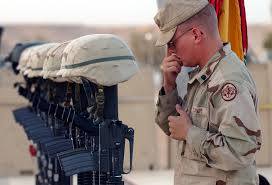
Message from the CEO: Our Statement for the House Veterans Affairs Committee
June 14, 2023
Army veteran appreciates fresh start at HVAF
June 23, 2023Engaging with Andrea: June is PTSD Awareness Month

Originally published in June 2023.
June is PTSD Awareness Month. Post Traumatic Stress Disorder (PTSD) is well known today, and most are familiar with it. However, it wasn’t long ago this was not a well-known diagnosis. Veterans returning from other wars were often left to face the horrors of their experiences without the support that is offered today. In 2003, when we first invaded Iraq, the protocols were not there for those returning from the battlefield that exist now.
I have worked for HVAF for two years but have walked a journey with my soldier and best friend for over 20 years. My husband was just 22 years old when he left for war in 2003. We were a young married couple, living in Colorado, beginning our lives. The U.S. had just bombed Iraq, fresh off the anger and haunting memories of 9/11. The 3rd Calvary Unit out of Ft. Carson, Colorado was the first to enter the war on the ground. I remember the day I discovered my husband was going to war. I was so young and scared!
For the next five months, I had no contact with my husband except for the letters he sent. When they finally installed AT&T phones in Fallujah, we were able to talk once a week for five minutes. November 2003 was the date my husband was to return home because he was leaving the military. Two weeks prior, a RPG (Rocket Propelled Grenade) hit a Chinook helicopter full of Ft. Carson soldiers. My husband’s best friend and mentor were killed as well as 13 others. More than 40 soldiers were seriously injured. It was the single most deadly attack of the war to date. The chinook was not engaged in combat, as it was headed to Kuwait to take back soldiers to the U.S. for R&R (rest and relaxation). My husband’s best friend was heading to attend his mother’s funeral.

The photo of Wes on the front page of Denver Post – November 2003.
My husband was a chaplain’s assistant, so his role was to set up the memorial services of all the fallen while in Iraq. His last duty before he returned home was to do so for his best friend and mentor. Back in the United States, the Chinook attack became national news. I remember not knowing if my husband was on this helicopter or not. They would not release any names until all families had been notified.
I headed out to the grocery store and almost collapsed when I saw my husband’s picture on the front page of the Denver Post. I was relieved he was alive, but he looked so broken as he arranged the Kevlar helmets on the rifles of those who had died. The picture was featured in syndication across the country and was a haunting example of the invisible wounds of war and the suffering that would result because of it.
At 22 years old, our marriage and lives were changed forever. My husband would return, bringing home this war with him. He would be bombarded with night terrors, anxiety, depression, suicidal thoughts, and survivor’s guilt. This would lead to job loss, homelessness, domestic violence, and near divorce. Yet, with a diagnosis of PTSD finally in 2011 and the treatment that followed, we found healing.
This is why HVAF is so crucial for the veterans and their families who seek our services. My story is just one of thousands who mirror similar situations from all wars. I didn’t know about HVAF and walking this journey alone was very arduous. This is where my passion comes from in spreading awareness about HVAF’s services and to raise funds to be able to continue to support veterans and their families! Our veterans witnessed unspeakable horror to protect our freedom. We must support them!

